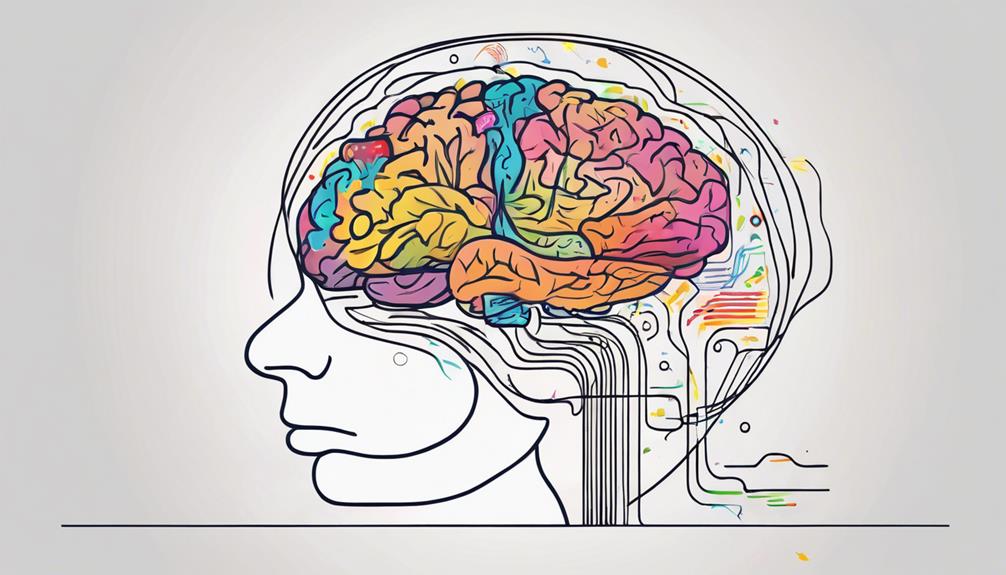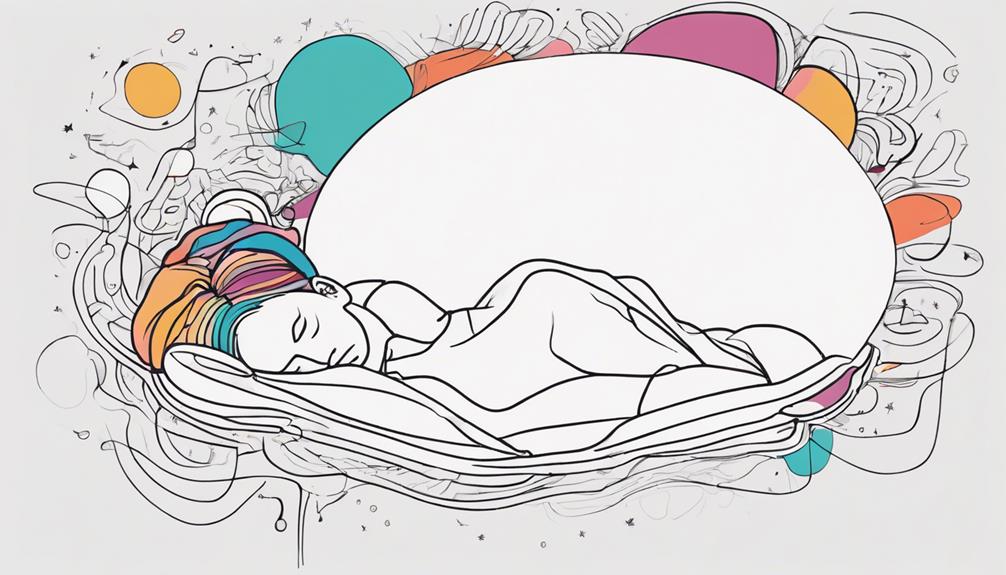The phenomenon of dreaming during sleep remains an enigmatic aspect of human consciousness that continues to intrigue researchers and scholars alike. While numerous theories have been proposed to elucidate the purpose of dreams, the underlying mechanisms and significance of these nocturnal experiences remain a subject of ongoing investigation. Recent advancements in neuroscience have shed light on the intricate relationship between dreaming and brain function, offering new insights into the potential functions and implications of this mysterious cognitive process. As we delve into the complexities of why we dream when we sleep, a deeper understanding of the intricate workings of the human mind awaits those who seek to unravel this enduring riddle.
Key Takeaways
- Dreams support memory consolidation, problem-solving, and emotional processing during sleep.
- Dreaming enhances cognitive functioning, creativity, and neural adaptability.
- Dreams protect the brain and visual cortex, aiding in brain plasticity.
- The interplay of brain regions in dreams fosters innovative thinking and memory reorganization.
The Purpose of Dreams

Dreams serve a multifaceted purpose, with recent theories suggesting a crucial role in protecting and maintaining brain function during sleep. Specifically, these theories propose that dreams, especially during REM sleep, play a significant role in safeguarding the visual cortex and other brain areas. The brain's activity during sleep is not merely idle; instead, it reorganizes sensory areas swiftly, allowing for the redistribution of resources to other senses. This adaptability, known as neuroplasticity, supports the idea that dreams are integral to protecting and preserving brain function.
Studies have shown a correlation between REM sleep, visual cortex protection, and brain adaptability, indicating that dreams may be essential for maintaining brain health. While some researchers debate the exclusive focus on the visual cortex theory of dreams, the overall consensus is that dreams serve a protective function for various brain areas. The dynamic nature of the brain during sleep underscores the importance of dreams in ensuring optimal cognitive functioning and adaptability.
Cognitive Development and Dreams
In the realm of cognitive development, the phenomenon of dreaming emerges as a significant player in memory consolidation and information processing during sleep. Dreams play a crucial role in strengthening neural connections in the brain, which is vital for enhancing learning and problem-solving abilities. Particularly in children, who experience more intense dream activity, dreams support cognitive development and aid in emotional processing.
The process of dreaming not only contributes to memory consolidation but also provides a platform for creativity, imagination, and emotional regulation, all of which are essential for cognitive growth. The content of dreams reflects an individual's cognitive processes, emotional experiences, and subconscious thoughts, influencing cognitive development and self-awareness. By engaging in dreams during sleep, individuals engage in a form of mental activity that assists in organizing and processing information, ultimately contributing to their cognitive development and overall well-being.
Memory Consolidation During Dreams

During sleep, dreams serve a crucial role in memory consolidation by reorganizing and strengthening memories. The activation of memory-related brain regions during dreaming facilitates the processing of information, reflecting recent experiences to encode memories for long-term retention. Increased hippocampal activity during REM sleep enhances memory formation, integrating new information into existing knowledge for learning and memory processes.
Dream Content Recall
Memory consolidation during sleep involves the reactivation and integration of learned information, a process facilitated by the content of dreams reflecting related memories.
- Dream content serves as a mirror of memories, aiding in the reorganization and strengthening of neural connections formed during wakefulness.
- The reactivation of memories during dreams helps solidify newly acquired information, contributing to long-term retention and learning.
- Sleep provides an optimal environment for the brain to consolidate memories, with dreams playing a significant role in this process.
- Understanding how dreams recall and integrate memories can offer valuable insights into memory-related conditions and potential therapeutic interventions.
Emotional Processing During Dreams
Emotional processing within dreams plays a crucial role in the consolidation of memories by facilitating the integration and organization of emotional experiences. During REM sleep, the brain actively engages in replaying and strengthening emotional memories, aiding in emotional regulation and the development of coping mechanisms. Dreams serve as a protective environment where the brain can navigate and comprehend intense emotions from waking hours. By delving into emotional conflicts and significant experiences, dreams assist in reducing stress and enhancing psychological well-being through effective emotional processing. The emotional content of dreams mirrors the brain's endeavor to solidify memories, particularly those laden with strong emotional significance. Through this intricate process, dreams contribute significantly to the consolidation and understanding of emotional memories within the brain.
Emotional Processing in Dreams
In the realm of dreaming, the mind engages in a complex process of emotional consolidation and integration. During sleep, dreams play a crucial role in processing and regulating emotions, contributing to mental well-being and emotional resilience. Here are four key aspects of emotional processing in dreams:
- Mirror of Waking Life: Emotional experiences in dreams often mirror events and feelings from waking life, allowing individuals to navigate and make sense of their emotions in a different context.
- Reflecting Concerns and Issues: Dream content frequently reflects emotional concerns or unresolved issues, providing a platform for exploring and addressing these matters in a symbolic or metaphorical manner.
- Safe Space for Exploration: Dreams create a safe space for individuals to delve into their emotions, offering a unique environment where they can explore, process, and express feelings without the constraints of reality.
- Enhancing Mental Well-being: The emotional processing that occurs in dreams can significantly contribute to overall mental well-being by aiding in emotional regulation, integration, and understanding, ultimately fostering emotional resilience in individuals.
Creative Problem-Solving in Dreams

Dreams have the capacity to harness unconventional thinking, fostering creative problem-solving abilities. Through unique perspectives and subconscious processing, dreams can stimulate innovative solutions to complex issues. Engaging with the creative insights gained from dreams has the potential to unlock hidden capabilities and offer valuable new approaches to challenging problems.
Dream Logic Benefits
During sleep, dream logic facilitates creative problem-solving by enabling the brain to explore innovative solutions unconstrained by traditional boundaries.
- Dream logic allows for the generation of imaginative scenarios that provide unique perspectives on complex issues.
- The brain's ability to create novel connections during dreams contributes to creative problem-solving processes.
- Engaging with dream logic can lead to the development of unconventional solutions that may not be considered in waking life.
- Dreaming encourages innovative thinking processes by encouraging the exploration of diverse cognitive pathways and fostering creativity.
Unconscious Innovation Sparks
How does the unconscious mind spark innovation through creative problem-solving in the realm of dreams? Research indicates that dreams play a crucial role in facilitating creative thinking and problem-solving by tapping into the unconscious mind. During REM sleep, the brain processes information in a unique way, allowing for the exploration of innovative solutions and insights that may not be readily apparent during waking hours. Dreams provide a platform for the mind to generate new ideas, perspectives, and connections that can lead to breakthroughs in various fields. Many famous inventions and discoveries throughout history have been attributed to insights gained from dreams, highlighting the significant role they play in sparking unconscious innovation.
Dreams and Brain Activity
Characterized by heightened neural activity and intricate processes, the phenomenon of dreaming during REM sleep unveils a complex interplay of brain regions and neurotransmitters.
- REM Sleep and Dreams: Dreams primarily occur during REM sleep, a stage characterized by increased brain activity and vivid dreams.
- Brain Regions Involved: Brain regions like the forebrain are responsible for generating dreams, while the brainstem controls REM sleep cycles.
- Neurotransmitters Impact: Neurotransmitters like acetylcholine and dopamine play key roles in dream generation and intensity during REM sleep.
- Sensory Reorganization: The brain's plasticity allows for rapid reorganization of sensory areas during sleep, influencing dream content and experiences.
During REM sleep, visual imagery and sensory experiences are vividly processed by interconnected neurons, creating the intricate tapestry of dreams. The brain actively engages in consolidating memories and emotions through the processing of dream narratives. Understanding the neural mechanisms behind dreams and brain activity during REM sleep sheds light on the fascinating world of our subconscious minds and the functions they serve.
Theories on Dream Function

The multifaceted nature of dreams prompts a diverse array of theories seeking to elucidate their underlying functions within the realm of sleep neuroscience. One prominent theory, proposed by David Eagleman, suggests that dreams serve to protect the visual cortex during sleep. This theory posits that the brain reorganizes sensory areas, allowing other senses to compensate and prevent the visual areas from remaining idle. Furthermore, REM sleep, a stage characterized by vivid dreams, is believed to play a crucial role in safeguarding the visual cortex. Studies have shown a correlation between REM sleep, brain adaptability, and age, supporting the notion that this stage serves to maintain the brain's functionality. However, some researchers challenge Eagleman's theory, proposing alternative explanations for the functions of REM sleep. These critiques suggest that dreams may serve various purposes beyond solely protecting the visual cortex, accommodating diverse perspectives on the role of dreams in the realm of sleep neuroscience.
Frequently Asked Questions
What Causes Dreaming in Your Sleep?
Dreaming in sleep is primarily caused by brain activity, particularly during the REM cycle, where vivid dreams occur due to heightened neurological function. Emotional processing, memory consolidation, and imaginative constructs play key roles in dream formation. During sleep patterns, the brain actively constructs scenarios from stored memories and emotions, showcasing the brain's ability to create imaginative experiences. This intricate process involves a complex interplay of brain mechanisms to generate dreams.
What Is the Purpose of Dreams?
Dreams serve various psychological insights through brain activity, emotional processing, memory consolidation, creative problem-solving, and symbolic representations. They may provide a platform for the mind to process emotions, memories, and engage in problem-solving activities. By analyzing dreams, individuals can gain deeper insights into their subconscious thoughts, emotions, and unresolved issues, aiding personal growth and self-awareness. The purpose of dreams extends beyond mere nighttime experiences, delving into the complexities of the human psyche.
Why Do We Actually Dream?
Brain activity during dreaming plays a crucial role in emotional processing, memory consolidation, creative inspiration, problem-solving, and the exploration of subconscious desires. Dreams are believed to facilitate the integration of experiences, emotions, and memories, aiding in psychological well-being and cognitive functioning. Research suggests that dreaming serves multiple functions beyond mere visual cortex protection, emphasizing the intricate interplay between brain plasticity, REM sleep, and the complexity of dream content.
Is Dreaming During Sleep Good or Bad?
Dreaming during sleep can have both positive and negative psychological impacts. While it aids in emotional processing, memory consolidation, and maintaining brain activity, frequent nightmares or disrupted sleep can harm sleep quality. Addressing these issues is crucial for preventing negative consequences. Techniques such as relaxation exercises, therapy, and maintaining a healthy sleep environment can help prevent nightmares and improve overall sleep quality and emotional well-being.
Conclusion
In conclusion, dreams during sleep serve various important functions such as cognitive development, memory consolidation, emotional processing, and creative problem-solving. The brain's activity during dreaming, particularly during REM sleep, plays a crucial role in maintaining brain plasticity and adaptability. Dreams are a complex phenomenon that continue to be a topic of scientific exploration and debate, shedding light on the intricate workings of the brain's reorganization and function. Just as dreams protect the visual areas of the brain, they also provide a window into our subconscious mind, offering a unique perspective on our inner thoughts and emotions.
